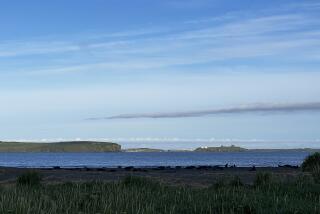Scientists Tour Islands to Assess Damage : Nature: The National Park Service experts will help decide whether to fund wildlife programs to heal decades of destruction.
Forty miles off the Ventura County coast, a stand of native island oaks juts with exposed roots from a patch of barren dirt on Santa Rosa Island. Feral pigs have rooted out every last acorn under the trees’ canopy, stopping the trees from reproducing.
The pigs’ heavy grazing has left the area vulnerable to erosion from the runoff of an abandoned Air Force base atop a lopped-off hill on the island. The combination has washed away two feet of rich topsoil needed by the unique species of oaks.
“Man, this is a hell of a mess,” said Harvey Fleet, a National Park Service scientist from Denver. “Something’s got to be done soon, or these trees are gone. They won’t last another generation.”
Top scientists from regional offices of the country’s national parks visited four of the five islands of the Channel Islands National Park last week to scrutinize the destruction that military bases, island ranchers and their domestic animals have brought to the fragile island environment.
Mack Shaver, superintendent of the Channel Islands National Park, directed the group of biologists, geologists and other scientists to the damaged areas to demonstrate the need for more federal money to return the islands to their native state.
Most of those on the two-day island tour were regional chief scientists of the park service who recommend which of the competing wildlife programs at national parks should get funding from headquarters in Washington, D.C.
“We don’t really know yet what these islands looked like in their natural condition,” Shaver said. “In 30 years, we should have finished acquiring the land, have most of the planning done and the monitoring program in place. Then we can start the restoration.”
Shaver wants to double his $2-million annual budget, which includes programs to remove all non-native animals, buy a 10% section of Santa Cruz Island that is still privately owned, and study the health of the islands’ native plants and land and sea animals.
The Channel Islands park already leads the country in its program to monitor the health of the island’s ecosystem, said Dennis B. Fenn, a soils scientist who now heads the National Park Service’s natural resources office in Washington.
“Very few parks are this far along,” Fenn said.
But the national parks, like the rest of the nation’s programs, must fight for funding.
“There is never enough money for all the programs that need to be done,” said Bruce M. Kilgore, chief scientist for the western region that includes 44 parks ranging from the shores of the Channel Islands to the peaks of Yosemite and into the depths of the Grand Canyon. “So you do the best you can.”
At the conclusion of the business of the meeting, the scientists toured San Miguel, Santa Rosa, Santa Cruz and Anacapa islands. Time did not allow them to visit tiny Santa Barbara Island, a square mile of land about 40 miles offshore.
“The view of these coreopsis plants against the ocean on San Miguel is unique,” said Kilgore, referring to the Dr. Seuss-like bushes with hanging clumps of succulent light green foliage and bursts of yellow daisies with golden centers. “It helps remind me of the importance of the programs here at Channel Islands.”
On San Miguel Island, where the non-native animals have already been removed, the coreopsis stand six feet tall, creating a sea of gold. But on Santa Rosa Island, where elk, deer, cattle and feral pigs continue to roam and breed, the resilient coreopsis have survived only on the ragged cliffs and rocks beyond the animals’ reach.
The native shrubs and grasses, which should be two feet tall after the March rains, are grazed to the height of a well-trimmed lawn. The same is true on the privately owned end of Santa Cruz Island, where sheep and pigs roam wild.
“This is appalling,” Shaver said. “Grass should be this high right now,” he said, holding his hand two feet off the ground.
The park has contracted with professionals to begin killing pigs on one section of Santa Rosa Island. But ranch operators who still hold leases on both Santa Rosa and Santa Cruz earn cash by allowing hunters to come onto the islands in search of the feral animals.
As the scientists and their representatives clambered out of the small aircraft on Santa Cruz Island last Friday, they saw two hunters with bows and arrows dressed in camouflage suits going after their prey over rolling green hills.
The two men had paid $475 each to hunt feral sheep, the remnants of a ranching operation that counted a herd of 50,000 sheep in the 1870s. “This is a pretty challenging hunt,” said Clayton Nixon, an upholstery shop owner in Fresno. “Just look at the terrain.”
Shaver said the park service would prefer to remove the sheep with a paid contractor who will guarantee that all of the animals are killed and taken off the islands. When money is available and the leases with the private owners allow, Shaver wants to remove all non-native animals.
Federal regulations prohibit taking live animals onto the mainland because of the possible spread of disease.
However it is accomplished, the animals must be removed before the islands can recover their health and their natural appearance, the scientists said.
“There is a need for long-term, large-scale programs to restore the whole ecosystem,” said Gary Davis, Channel Islands biologist. “We wanted to show everyone the magnitude of the problem here.”
More to Read
Sign up for Essential California
The most important California stories and recommendations in your inbox every morning.
You may occasionally receive promotional content from the Los Angeles Times.









